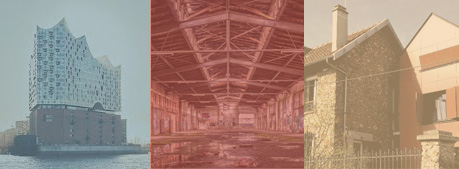In pursuit of lost buildable land
The metamorphosis of cities is a captivating challenge, where ingenuity and innovation combine to create dynamic and sustainable urban spaces on a planet with limited resources. Land, the raw material of urban development, is becoming scarce, or rather is being used more sparingly. Limiting the artificialization of land, or even making it a sanctuary in order to preserve biodiversity or practise agriculture, is leading to the adoption of new urbanisation models capable of responding to the new dynamics of society.

1. Rehabilitating industrial and commercial wasteland
Brownfield sites, often remnants of the past, represent unique opportunities. On the one hand, they are often well located in an already built-up urban fabric, giving them a latent centrality that needs to be translated into an urban centre. Secondly, because they are located on large plots of land, they can be built on to create housing, shops, offices and services without the need for urban sprawl. The only problem with this type of project is the cost of any soil decontamination, which can upset the financial balance of the operation. Public sector intervention through subsidies is likely to encourage the viability of brownfield redevelopment projects.
2. Raising buildings, towards new perspectives
Verticality is becoming a major ally in the quest for urban efficiency. Where urban planning regulations allow, building housing on top of existing buildings is a way of renewing the supply of real estate without consuming a single m2 of floor space! This stacking of old and new structures is not without its constraints. Load-bearing capacity, accessibility to the first floor, and respect for heritage (and the dreaded ABF, aka Architectes Bâtiments de France) are often seen as obstacles to raising the height of buildings.
3. Densification of residential areas, harmony and sustainability
Suburban neighbourhoods, which are characterised by tranquillity, are not excluded from the wave of regeneration. The tranquillity of the streets and the presence of numerous gardens are undeniable advantages for families who come to live in a house in the suburbs. Lifestyles often lead people to reconsider their property holdings, which is why projects to divide land, raise the height of detached houses and divide detached houses into flats are springing up all over the place. The result is better use of public infrastructure, additional income from the sale of a piece of land or the rental of a flat or studio, and more optimal use of land because it is accessible to a larger number of residents. While the creation of additional living space can be used to finance energy-efficiency renovations, preconceived ideas about density and semi-detached status can be seen as a psychological brake on the development of new housing in suburban neighbourhoods.
4. Innovation and resilience, pillars of urban transformation
Urban transformation is not just about renewing the skyline, it is also about sustainability. The use of bio-sourced, geo-sourced or low-carbon materials, the use of natural energy systems, functional mix and reversibility are all principles that support sustainable and resilient urban regeneration projects. Innovation takes on various dimensions: regulatory, technical and architectural, and it is only by replicating exemplary projects that we will achieve sustainability and resilience on a city-wide scale.
As part of this regeneration drive, Domolis, a true architect of change, is positioning itself as a catalyst for urban change, marking a transition towards renovated, intelligent and sustainable cities. This transition will only be possible thanks to the collective intelligence of project owners, investors, cities, architects, project managers and design offices.
To learn more
https://www.radiofrance.fr/francemusique/la-philharmonie-de-l-elbe-a-hambourg-se-devoile-8240420

